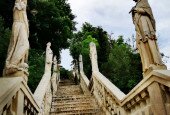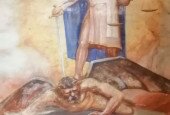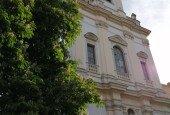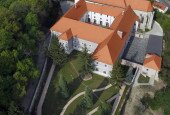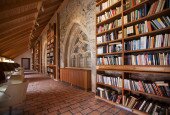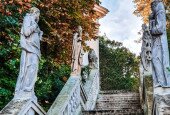Sopronbánfalva Pauline-Carmelite Monastery and Church of the Queen of Heaven
Through the Stairs of the Saints, a road leads to the Pauline-Carmelite Monastery and the Queen of Heaven Church in Sopronbánfalva.
In today's village of Sopronbánfalva, a small chapel was built in 1441 in honour of St. Farkas, which was looked after by a Pauline hermit. A few years later his comrades also settled. The construction of the church together with the monastery began around 1482, at the time of the foundation of the Pauline monastery. The earliest copy of the picture of the Black Madonna in Czestochowa was placed in the church. As a result of the Turkish threat, the monks fled to Vienna with the picture, and later the Turks burned the monastery.
In the first half of the 17th century, the monastery was rebuilt, that is when it acquired its present, single-storey, closed-cloister baroque form, and the monks also returned to Bánfalva. Education of the Pauline scholars took place in the monastery with its monastic library that was famous far and wide. In 1718 the monks built the stairs leading to the church and the monastery, which was ornamented in around 1750 with 7 pairs of statues. In 1786, after the dissolution of the Pauline order, whatever was in the church was auctioned off, and the empty church began to deteriorate. In 1827, Catholic believers purchased and renewed the church building, and the picture of the Black Madonna was also brought back. At that time, the monastery building became the accommodation for the workers and mining officers when the first Hungarian coal mine opened in the nearby Brennbergbánya. In 1840, the Military Hospital of Rust was relocated to the monastery building. From 1892, the Carmelite nuns were the new owners of the monastery, who used the building until 1950, and then, after the dissolution of the monastic orders, it functioned as an asylum and an assisted living facility until 1970.
In the year of the closure of the monastery, in the church that operated independently from it, new murals were created in 1950, which are considered to be a curiosity in Hungary.
The painter, Zoltán Básti from Eperjes, depicted Archangel St. Michael's victory over the devil slightly hidden above the gallery, giving Stalin's features to the devil. This all happened during the Communist Rákosi regime.
The church was restored after 1954, under the direction of sculptor-restorer Ernő Szakál and Ferenc Dávid from Sopron. Reconstruction of the stairs leading to the church began in 1968, during which the statues that had disappeared over the centuries were found and were placed back to their original location. The complete reconstruction was completed by 2018, and the Stairs of the Saints now can be visited again in its former glory.
The founder of KOGART, Gábor Kovács bought the disused and deteriorating monastery building in 2004, and in 2010 he established a meditation and retreat centre as well as a hotel. In April 2015 the institution was placed under state management and continued to operate within the framework of the Eszterháza Cultural, Research and Festival Centre. The monastery, built on the wall of the medieval church nave, awaits its visitors on three levels, some parts of which can also be visited by tourists.
Opening hours: Every day from 10 a.m. to 6 p.m.


